Kibble is bad for cats because it is very high in carbohydrates. Cats are obligate carnivores and cannot tolerate large amounts of carbohydrates.
Veterinary nutritionists don’t recommend kibble for cats because it can lead to obesity, certain cancers, FLUTD, and other serious health issues in the long run.
7 of my cats have died from serious health-related issues. They all ate kibble.
More than half the cats in the US are overweight and obese. 82% of cat parents feed kibble.
Many vets still recommend kibble. It’s the most popular food for cats.
It seems convenient and cheap. But the long-term negatives outweigh the convenience.
Here’s why kibble is bad for cats:
- Cats are obligate carnivores
- Kibble is full of carbs
- Carbs are bad for cats
- Kibble is full of plant-based protein
- Kibble does not clean teeth
- Health risks associated with kibble
- Cats vomit more on kibble
- AAFCO cat food rules
- BONUS: A nutritional breakdown of popular kibble
Note: Switching cats to new foods too quickly will make them sick. More on that below.
Check out this guide today or save THIS PIN to your Cat Food board on Pinterest.
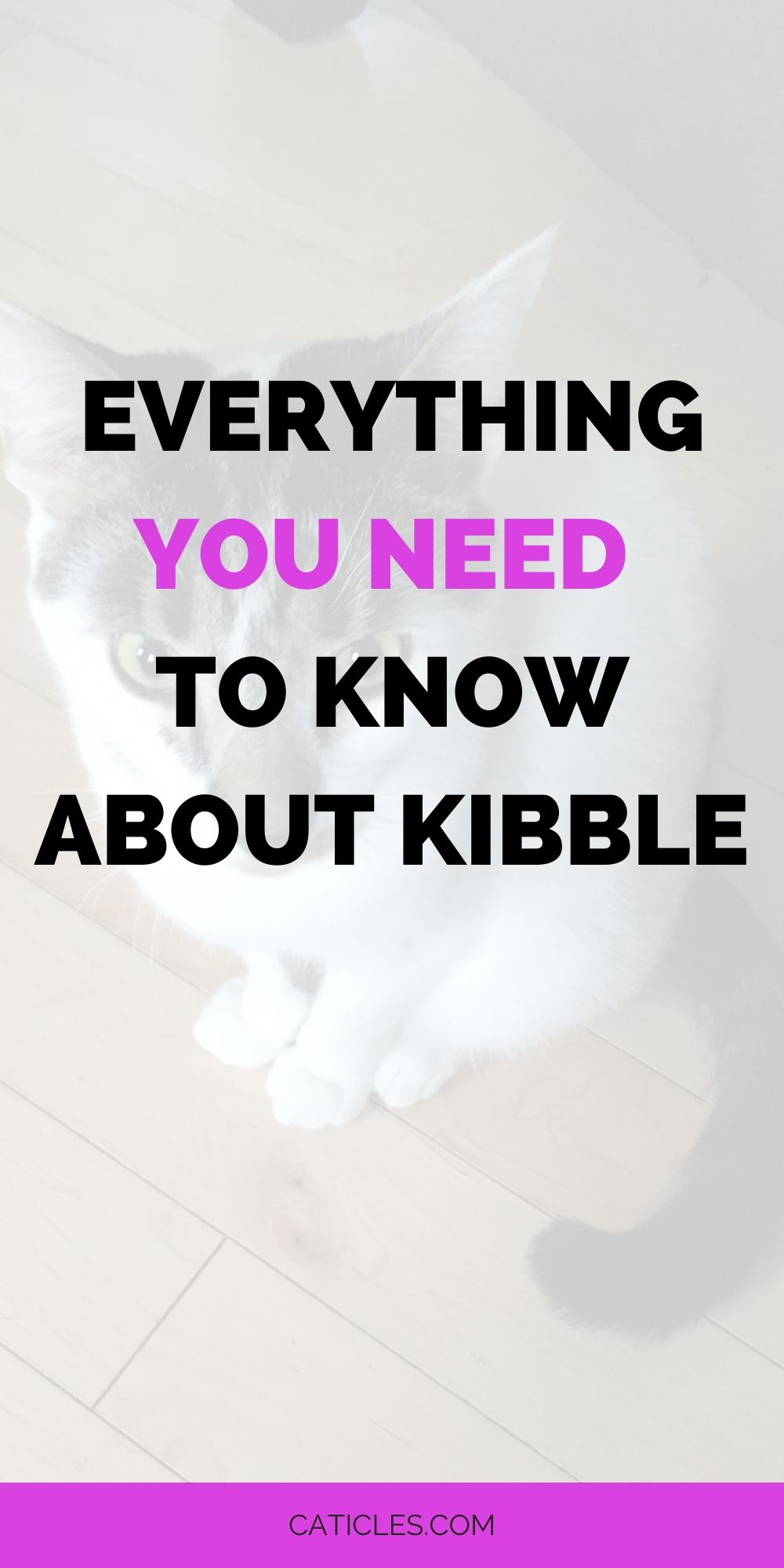
Disclaimer: I earn a commission if you purchase through affiliate links to books mentioned below.

1. Cats are obligate carnivores
I’ve heard that cats are obligate carnivores, but what does that mean?
Carnivore = an animal that feeds on flesh.
Obligate = restricted to a particular function or mode of life.
So obligate carnivore = cats are restricted to a meat-only diet.
Cats cannot survive without eating meat.
Taurine
Taurine is essential to cat health. Cats cannot produce taurine. They must get this from food.
Plants do not contain taurine. Cats must get taurine from meat.
Taurine contributes to:
- Proper growth development
- Healthy eye function
- Immune system
- Heart health
- Healthy GI tract
So, basically everything a cat needs to survive.

Protein
Animal-based protein is absolutely necessary for cats.
Animal-based protein makes:
- Enzymes
- Antibodies
- Hormones
- Tissues
So, basically everything a cat needs to survive.
Fat
Animal fats and fatty acids are necessary for cats because they provide energy.
Animal fat contributes to:
- Energy
- Nutrient utilization and transportation
- Cell integrity
- Metabolic regulation
So, basically everything a cat needs to survive.
Cats need meat because it is essential to their heart, eye, immune system, cell, and digestive health.
2. Kibble is full of carbs
Most kibble is made through a process called extrusion.
Dried kibble goes through 3 extrusion processes and a coating process.
Carbs and starches are needed to hold the kibble shape.
Otherwise, the ingredients would fall apart and crumble.
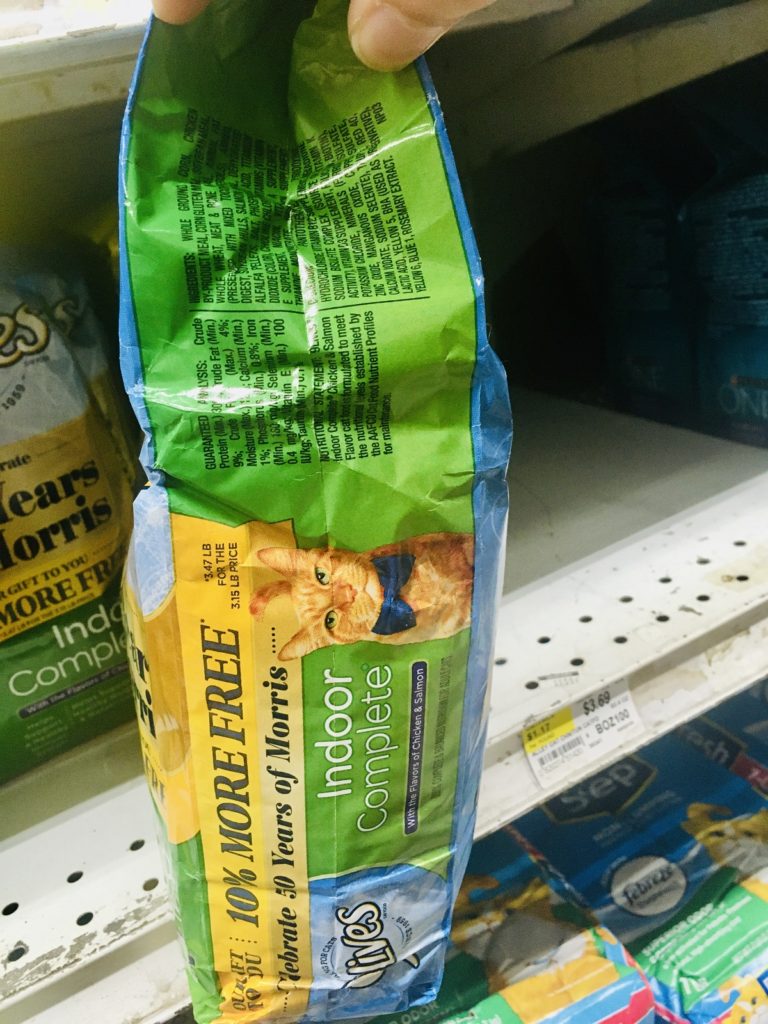
A company called AFB International creates flavor enhancers for kibble.
Pet food manufacturers blend animal fats and meals with soy and wheat grains and vitamins and minerals. This yields a cheap, nutritious pellet that no one wants to eat. Cats and dogs are not grain-eaters by choice. So, our task is to find ways to entice them to eat enough for it to be nutritionally sufficient.
Popular Science the Chemistry of Kibble.
The company refers to one specific flavor enhancer called pyrophosphates as “cat crack.”
Carbs are necessary for kibble to hold its shape. Flavor enhancers are sprayed on kibble because cats don’t naturally eat carbs.
3. Carbs are bad for cats
Wild cats consume whole prey. Their only carb intake would be the stomach contents of their prey.
The cat’s natural diet is typically less than 10% carbs. Kibble is typically around 25-50% carbs.
- Carbs lead to obesity in cats
- Cats cannot utilize carbs
- Carbs and obesity can lead to diabetes
- Cats lack the enzyme amylase in their saliva
- Amylase is responsible for breaking down carbs
- Carbs break down into sugar which causes insulin imbalances
Carbs break down into sugar. This extra sugar spikes insulin levels.
Cats (and humans) build a tolerance to insulin with excessive spikes. Over time, they will need more and more insulin which can lead to diabetes.
In fact, Dr. Elizabeth Hodgkins owns a patent in which she treats diabetic cats.
She explains in her book, Your Cat: Simple New Secrets to a Longer, Stronger Life, that she was able to decrease the need for insulin in diabetic cats just by switching from kibble to a high protein low carb wet food.
Further, two cats that returned to eating dry food developed diabetes again. After transitioning back to high protein low carb wet food, diabetes disappeared… again.
Many vets think that diabetes is incurable.
Important note: If your baby is diabetic I urge you to speak to your vet about Dr. Hodgkins’ patent. This, along with other resources, are included on my diabetic diet for cats page. You must work with your vet on transitioning foods and adjusting insulin levels based on your cat’s blood glucose.
Cats use fat and protein for energy. Not carbs. The cat’s body cannot utilize carbs. And high amounts of carbs in the diet can lead to ill health.
4. Kibble is full of plant-based protein
Most kibble companies use plant-based proteins because they are cheaper than meat-based proteins.
Cats do not require plant-based protein in their diet.
- Plants do not contain essential amino acids Taurine and Carnitine
- Cats need amino acids for healthy body function
- Meat-based protein does contain essential amino acids
Less costly plant proteins don’t contain amino acids sufficient for the nutritional needs of carnivorous dogs and cats.
Dr. Karen Becker
Kibble companies only use plant-based proteins because it’s cheaper than meat-based proteins.
5. Kibble does not clean teeth
I’m sure you’ve heard that kibble cleans teeth because it’s crunchy.
What if your friend said this to you…
“I don’t need to brush my teeth because I eat granola. Granola is crunchy and cleans my teeth.”
Does that make sense?
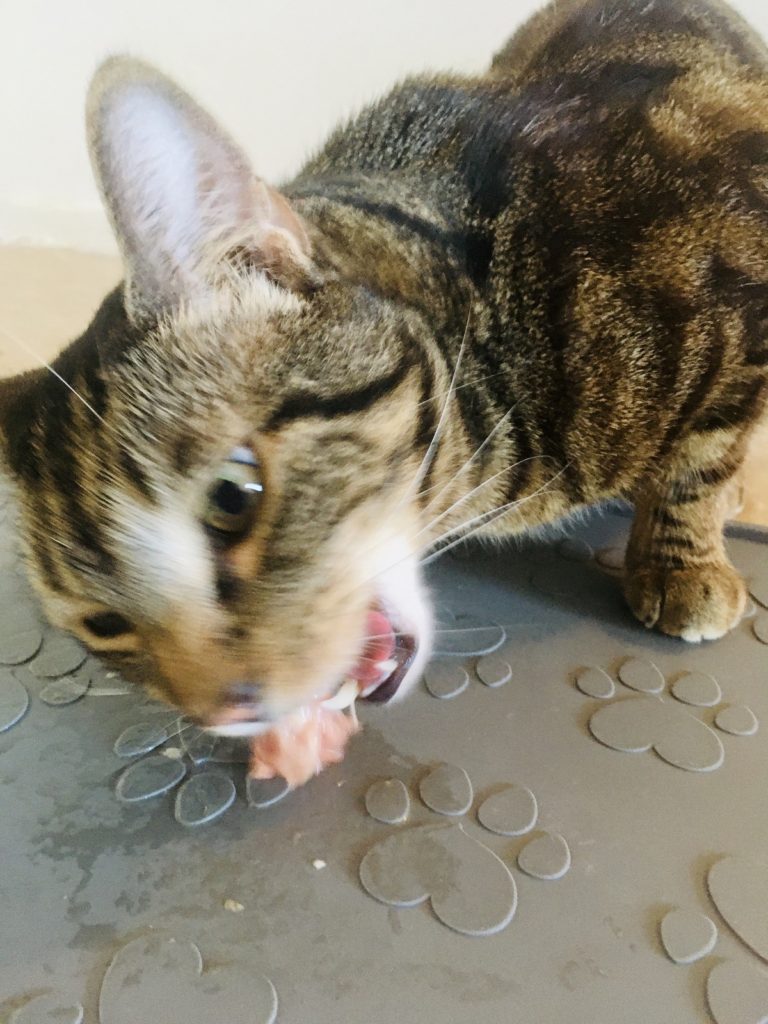
Kibble doesn’t clean cat teeth because it’s full of carbs.
- Cats lack the enzyme amylase in their saliva
- Amylase breaks down carbs
- Carbs are not broken down in the cat’s mouth
- Carbs stick to cat’s teeth and form plaque
- Plaque hardens into tartar
Cats barely chew their food anyway.
- The cat’s jaw moves up and down only
- Our jaw moves up and down and side to side
- The cat’s jaw is designed to chew flesh and bone into smaller pieces
- Those pieces are swallowed whole
- Our jaw is designed to grind food down into tiny pieces
- We don’t swallow food whole
Dr. Lisa Pierson of catinfo.org focuses specifically on the health risks associated with dry food diets.
My favorite line on her site is, “The idea that dry food promotes dental health makes about as much sense as the idea that crunchy cookies would promote dental health in a human”.
Plus, if kibble did actually clean teeth…
Why would kibble companies go through the trouble of creating separate “oral care” kibble diets?
Kibble does not clean cat teeth because it contains carbs. Cats cannot break down carbs in their mouth. This turns into plaque and tartar.
6. Health risks associated with kibble
Kibble is dangerous to cats because it lacks essential meat-based nutrients and moisture. Instead, kibble is full of carbs, plant-based protein, and low moisture.
Cats need meat-based nutrients and moisture to survive.
Cats evolve from desert dwellers who have a weak thirst drive. They rely on their food for moisture.
But my cat drinks plenty of water.
Is it enough though?
Cats are dehydrated at 61% moisture. Most muscle meat is around 75% moisture.
Dry food contains (on average) 10% moisture.
That means the average cat that eats kibble only needs more than 8 ounces of water per day to stay hydrated.
Does your cat drink that much?
The cat’s lack of a strong thirst drive can lead to low-level, chronic dehydration when dry food makes up the bulk of their diet especially if they have any level of kidney insufficiency.
Dr. Lisa Pierson
Health risks associated with kibble include:
- Diarrhea
- Vomiting
- Liver disease
- Kidney disease
- Obesity
- Heart disease
- Feline lower urinary tract disease
- Dehydration
Obese cats have less energy, can develop grooming issues, and live shorter lives.
Check this body condition score chart to see if your cat is an ideal weight.
The health risks of kibble far outweigh the “convenience” of feeding it.
7. Cats vomit more on kibble
I’ve cleaned tons of cat vomit working as a cat sitter.
Have you noticed kibble puke looks the same as it went in?
Vomit is the body’s defense mechanism when we eat stuff our body thinks is harmful.
- Cats rarely chew kibble
- Kibble has low water content
- Dry kibble swell in the stomach
- Swelled kibble exceeds the capacity of the stomach
- This sends signals to the vomiting center of the brain
Cat vomit is not normal. Just because it happens a lot, it doesn’t make it normal.
Cats can also develop allergies to the many low-quality and inappropriate ingredients in kibble. Not to mention the microscopic storage mites that live inside the bag.
Cats vomit kibble because the body sees kibble as a threat.
8. AAFCO cat food rules
AAFCO has many rules when it comes to pet food names and the ingredients list. It’s important to understand these rules.
Otherwise, you have no idea what you’re buying.
The FDA and AAFCO do not regulate the quality of pet food. They regulate the product labels.
AAFCO does not approve cat food.
The pet food label contains a wealth of information, if one knows how to read it. Do not be swayed by the many marketing gimmicks or eye-catching claims. If there is a question about the product, contact the manufacturer or ask an appropriate regulatory agency.”
FDA on pet food labels.
It is our responsibility to find healthy cat food. Not the AAFCO’s or FDA’s responsibility.
I highly suggest studying these rules. Check my cat food label guide.
Did you know carbs are not required in the guaranteed analysis?
Doesn’t that further prove that carbs are not essential? I mean, if they were essential, they’d be required on the label, right?
Technically, carbs are one of the macronutrients. So why wouldn’t AAFCO require this on the GA?
You’ll have to use a carb calculator to figure out the carb amount yourself.
BONUS: A nutritional breakdown of popular kibble
Now we know why kibble is bad for cats.
Let’s see real-life examples using AAFCO rules for product labels.

The following are some of the worst cat food brands.
Greenies dental treats
- Product name: Oven-roasted chicken flavor
- Flavor rule = no percent requirement for chicken and it’s less than 3%
- Carb amount = 37% on a dry matter basis
- Moisture = 10%
- First 5 ingredients = chicken meal, ground wheat, brewers rice, corn gluten meal, poultry fat
How can these treats clean teeth if 3/5 first ingredients and more than 1/3 of the product are carbs?
Carbs do not clean teeth.

Royal Canin
- Product name: Royal Canin Sensitive Digestion
- No label rule requirement for meat = your guess is as good as mine
- Carb amount = 32% on a dry matter basis
- Moisture = 8%
- First 5 ingredients = chicken meal, brewers rice, corn gluten meal, chicken fat, wheat
Notice that the first five ingredients are similar to the treats?
How can this be helpful for “sensitive digestion” when 3/5 first ingredients and 1/3 of the product are carbs?
Cats cannot digest carbs properly.
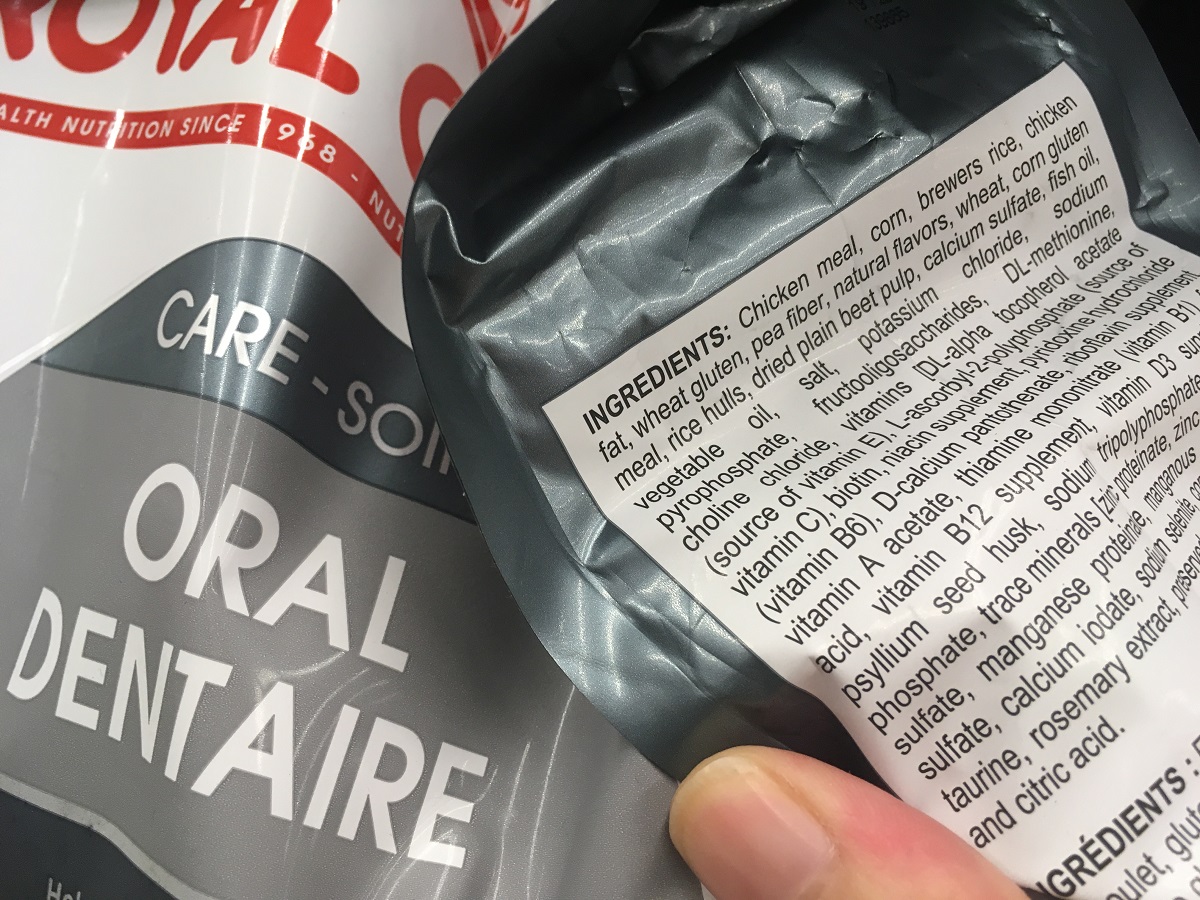
- Product name: Royal Canin Oral Care
- No label rule requirement for meat = who knows
- Carb amount = 39% on a dry matter basis
- Moisture = 10.5%
- First 5 ingredients = chicken meal, corn, brewers rice, chicken fat, wheat gluten
Again we see the same first ingredients. These products are sold for different functions. How are these products different?
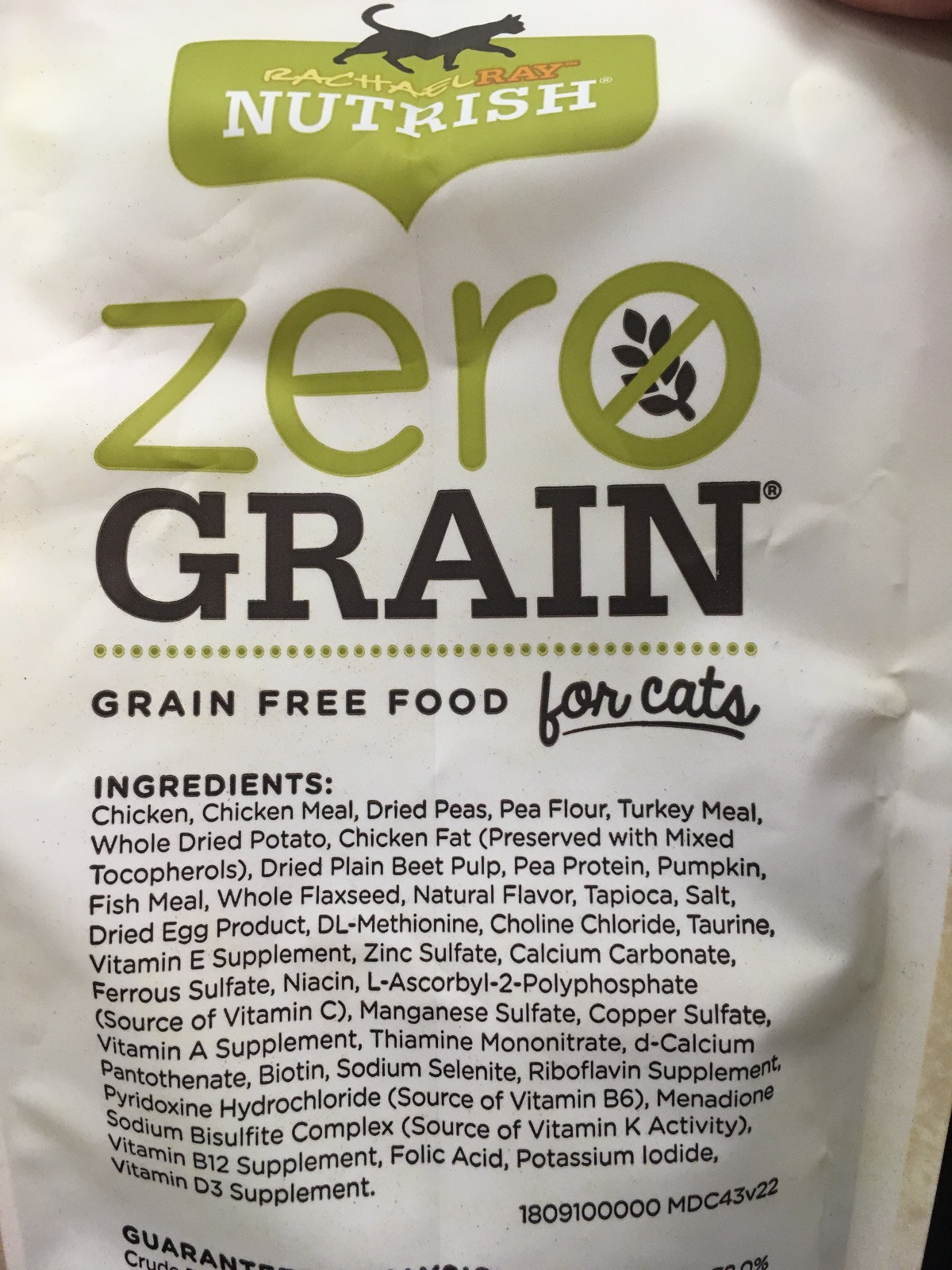
Rachel Ray’s Nutrish
- Product name: Rachel Ray Nutrish Zero Grain Chicken & Potato Recipe
- Recipe rule = 25% minimum chicken and potato combined
- Carb amount = 35% on a dry matter basis
- Moisture = 9%
- First 5 ingredients = chicken, chicken meal, dried peas, pea flour, turkey meal
Of course, the buzzwords “zero grain” are used. But the product is still about 1/3 carbs.
2/5 first ingredients are peas, but they are listed separately.
Peas would probably outweigh the chicken if they were listed together. Ingredient splitting at its finest!
I see that taurine and DL-methionine (amino acids) are added back into the food. Meaning, the amino acids from the meat-based protein are not sufficient enough.
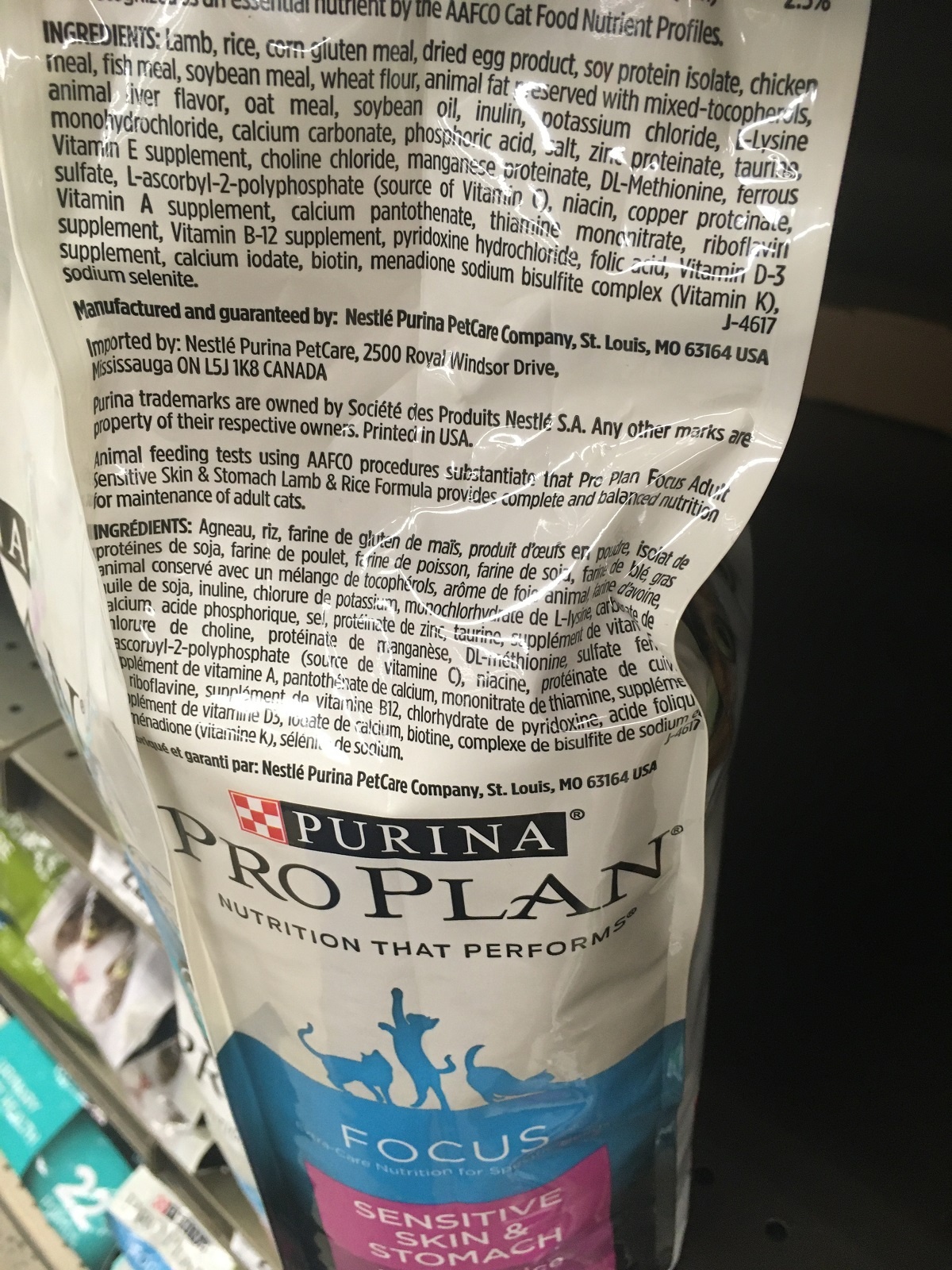
Purina Proplan
- Product name: Purina Pro Plan Sensitive Skin & Stomach Lamb & Rice Formula
- Formula rule = 25% lamb and rice combined
- Carb amount = 22% on a dry matter basis
- Moisture = 12%
- First 5 ingredients = lamb, rice, corn gluten meal, dried egg product, soy protein isolate
The bag also states “made with 40% protein” and “lamb is #1 ingredient”.
The formula rule says that only a minimum of 25% lamb and rice combined is required. With lamb being at 3% minimum. Of course they promote lamb is #1 on the front of the bag.
Note: Muscle meat is 75% moisture. Perhaps lamb is the heaviest ingredient when it’s added, but 3/4 of that meat is destroyed during extrusion. Remember, kibble is only around 10% moisture.
Further down the ingredients list we also see:
- Chicken meal
- Fish meal
- Soybean meal
- Animal liver flavor
“Animal liver flavor” is dangerous because it doesn’t state which animal.
This product is advertised for sensitive skin and stomach. How can this abstract variety of ingredients be good for sensitive stomachs?
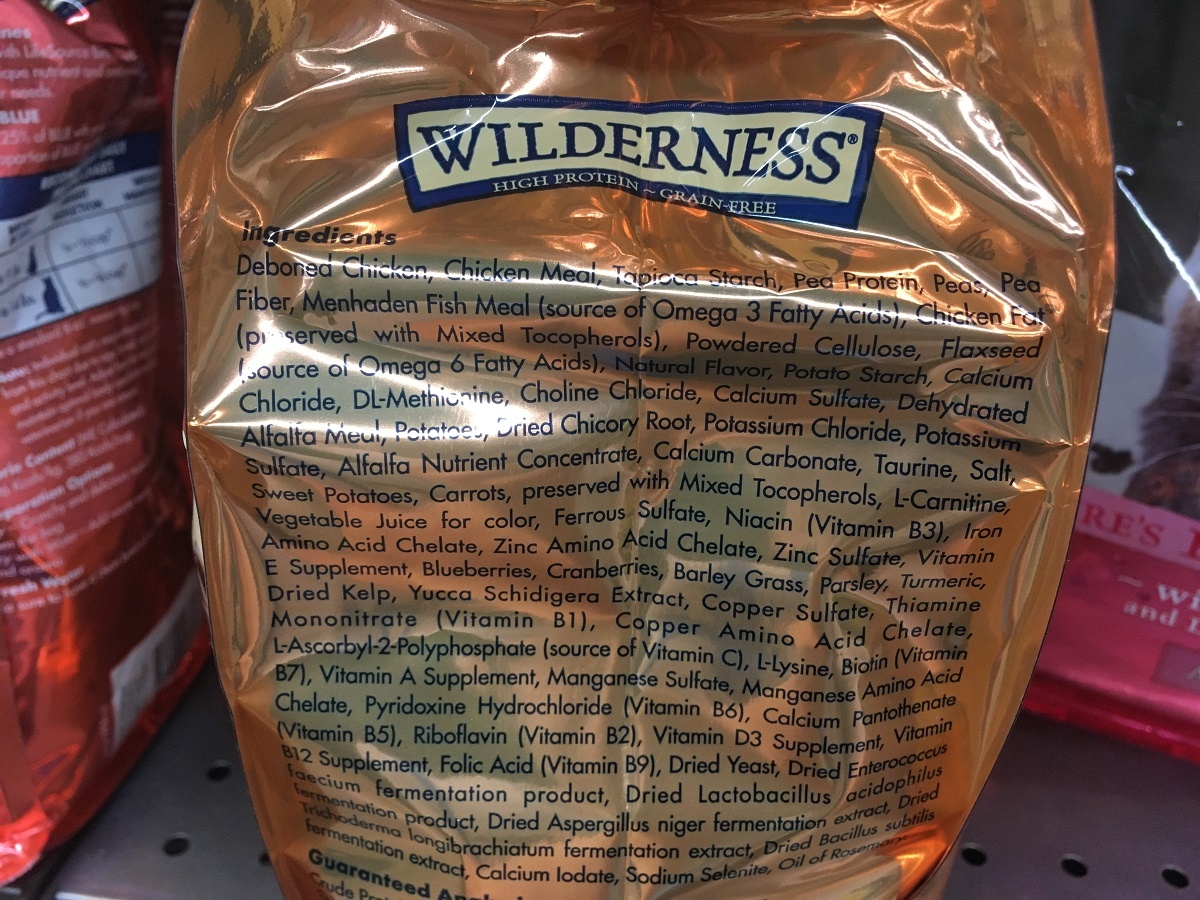
Blue Wilderness
- Product name: Blue Buffalo Wilderness with Chicken Adult Weight Control
- with rule = minimum requirement of 3% chicken
- Carb amount = 31% on a dry matter basis
- Moisture = 9%
- First 5 ingredients = deboned chicken, chicken meal, tapioca starch, pea protein, peas
The next ingredient is pea fiber. How many peas do you need?
Again, peas would probably outweigh chicken if they were listed together. This is why they are listed separately.
How can this be weight management when 1/3 of the product is carbs?

- Product name: Blue Buffalo Wilderness with Chicken Adult Indoor Hairball Control
- with rule = minimum requirement of 3% chicken
- Carb amount = 27% on a dry matter basis
- Moisture = 9%
- First 5 ingredients = deboned chicken, chicken meal, pea protein, tapioca starch, menhaden fish meal
Menhaden fish meal is in the ingredients of the previous dry food.
What makes one weight management and the other hairball control?
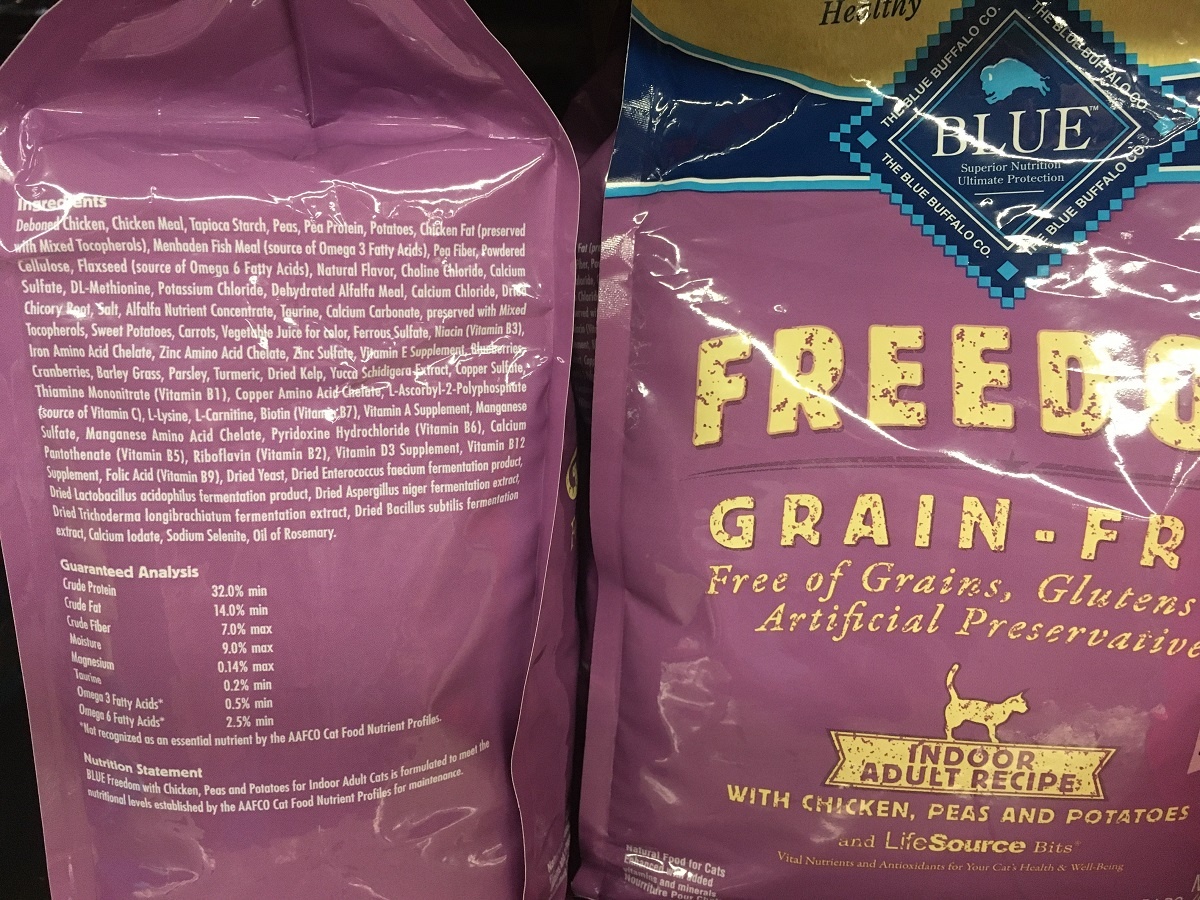
Blue Freedom
- Product name: Blue Buffalo Freedom Grain-Free with Chicken, Peas, and Potatoes
- with rule = minimum requirement of 3% chicken, peas, and potatoes combined
- Carb amount = 34% on a dry matter basis
- Moisture = 9%
- First 5 ingredients = deboned chicken, chicken meal, tapioca starch, peas, pea protein
Do you see a pattern here?
These foods are marketed for different managements, but they contain the same ingredients.

Hill’s Diet
- Product name: Hill’s Prescription Diet Metabolic Weight Management Chicken Flavor
- Flavor rule = no minimum requirement for chicken and it’s less than 3%
- Carb amount = 31.7% on a dry matter basis (their website actually lists this)
- Moisture = 9%
- First five ingredients = chicken by-product meal, brewers rice, corn gluten meal, powdered cellulose, dried tomato pomace
Is this a joke?
The first 5 ingredients are essentially the same as Greenies treats. And this is expensive prescription food!
Further down the ingredients, you’ll see:
- L-Lysine
- DL-Methionine
- L-Carnitine
These 3 are essential amino acids that cats need from meat.
Why would they add them back into the food?
Because the nutrients from the chicken aren’t sufficient enough.
How can cats lose weight when this food is 1/3 carbs?
Carbs make cats gain weight.
There’s no actual meat in this Hill’s Diet food.
The Association of American Feed Control Officials (AAFCO) says poultry by-product meal “consist of the ground, rendered, clean parts of the carcass of slaughtered poultry, such as necks, feet, undeveloped eggs and intestines, exclusive of feathers except in such amounts as might occur unavoidably in good processing practices.”
Raw chicken necks and feet can be a great addition to your cat’s raw diet. However, roughly 83% of your cat’s diet should come from muscle meat. Not by-products.
Why are by-products in cat food bad?
Someone emailed me and explained that by-products are good.
If by-products actually meant CLEAN organs and bones then yes, by-products would be good.
Cats get essential vitamins, minerals, and amino acids from organ meats. And they need calcium from bones.
But humans eat organ meats like liver, spleen, kidney, etc. And I can buy turkey tails, pig feet, cow feet, wings, necks, etc. at my local grocery store.
So how do we know that these by-products in pet food are CLEAN sources of organs and bones?
Also, organ meats make up a very small amount of the cat’s diet.
Think of a mouse. The majority of the mouse is muscle meat, around 83%. Organs make up a small percentage, around 8-10%.
Yes, clean organs are essential to the cat’s diet. But the majority of the diet should come from muscle meat.
It’s crazy to me that this food claims “clinical nutrition” but the first 5 ingredients are worse than other kibbles on this list.
At least others on the list have a minimum requirement for meat. This Hill’s product doesn’t!
Chicken Flavor = 0% minimum of chicken. And it’s less than 3%! Otherwise, the product would say “with Chicken”.
Final thoughts on kibble for cats
Kibble is bad for cats because it contains inappropriate ingredients such as low-quality meat ingredients, carbs, plant-based proteins, low moisture, and fillers.
Cats need meat-based proteins and high-moisture foods to survive.
Kibble does not clean teeth because it is full of carbs.
Cats don’t chew their food the same way we do anyway.
The AAFCO has many rules regarding cat food labels. However, the AAFCO does not regulate the quality of these foods. And they do not approve, certify, or test pet food.
It’s our responsibility to read through the marketing tricks to choose the best quality food for our cats.
You may be tempted to toss your cat’s food after reading this.
Please know that the cat’s gut is highly sensitive to change.
Even the best quality food will make your cat sick if you don’t transition properly.
Want a clear, step-by-step plan to feed your cat better? Buy my Switch to Raw Blueprint Course to stay organized and fast-track your success!
